Summary
[last update October 8th, 2010]
As of October, 2008, Apex has finally created
firmware that works for the Karman-type airflow signals. The new
revision is v1.104 and I've tested it rather thoroughly - it works.
If you have an older firmware revision, you'll need to make arrangements
with Apex (via their website) to ship your AFC Neo back to Apex, where
they can update the firmware. The firmware is, unfortunately, not
field-upgradeable, which means you can't just download a file and
update it yourself.
Here is the thread on 3Si.org that shows a bit of the timeline and has some more data.
AFC Neo v1.104 Operational Data
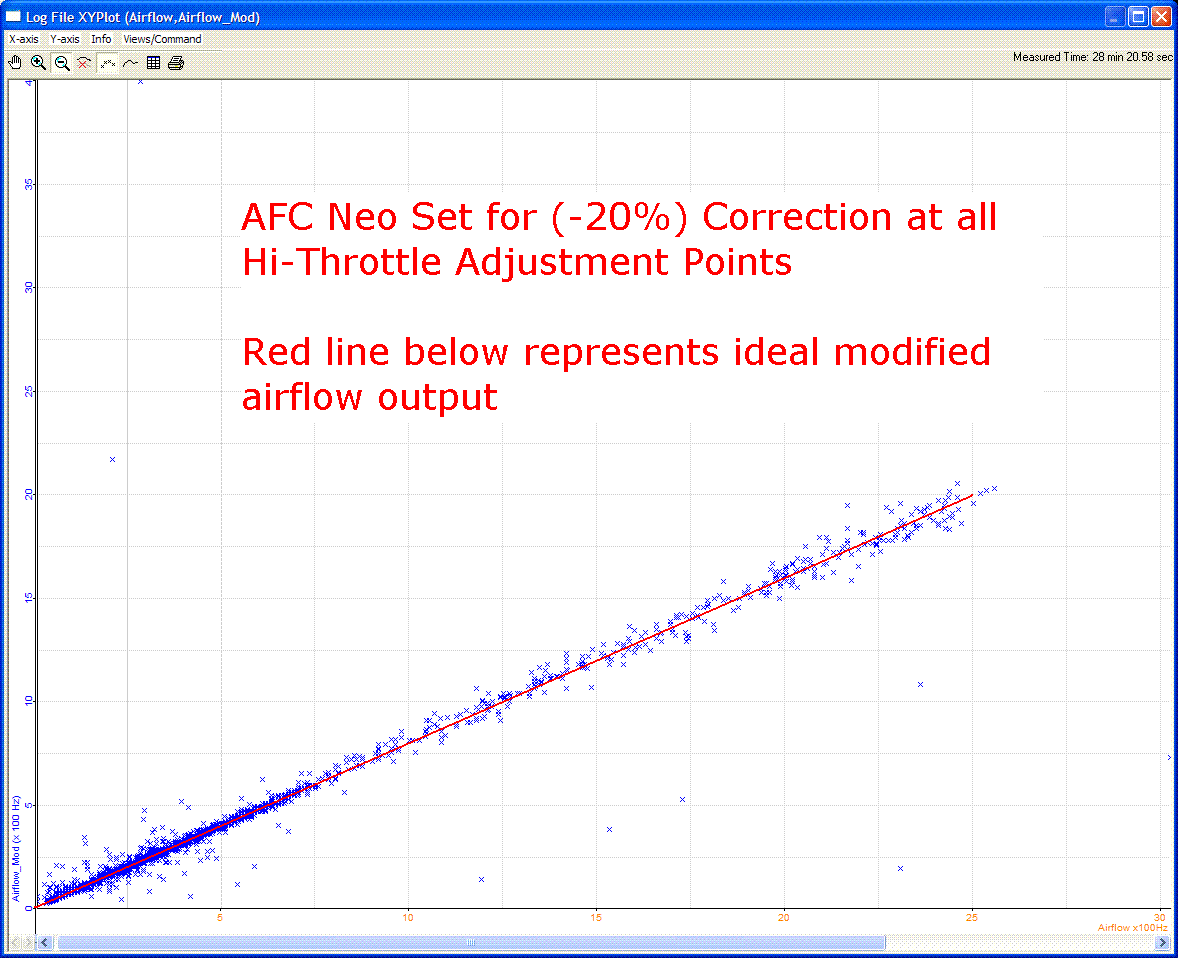
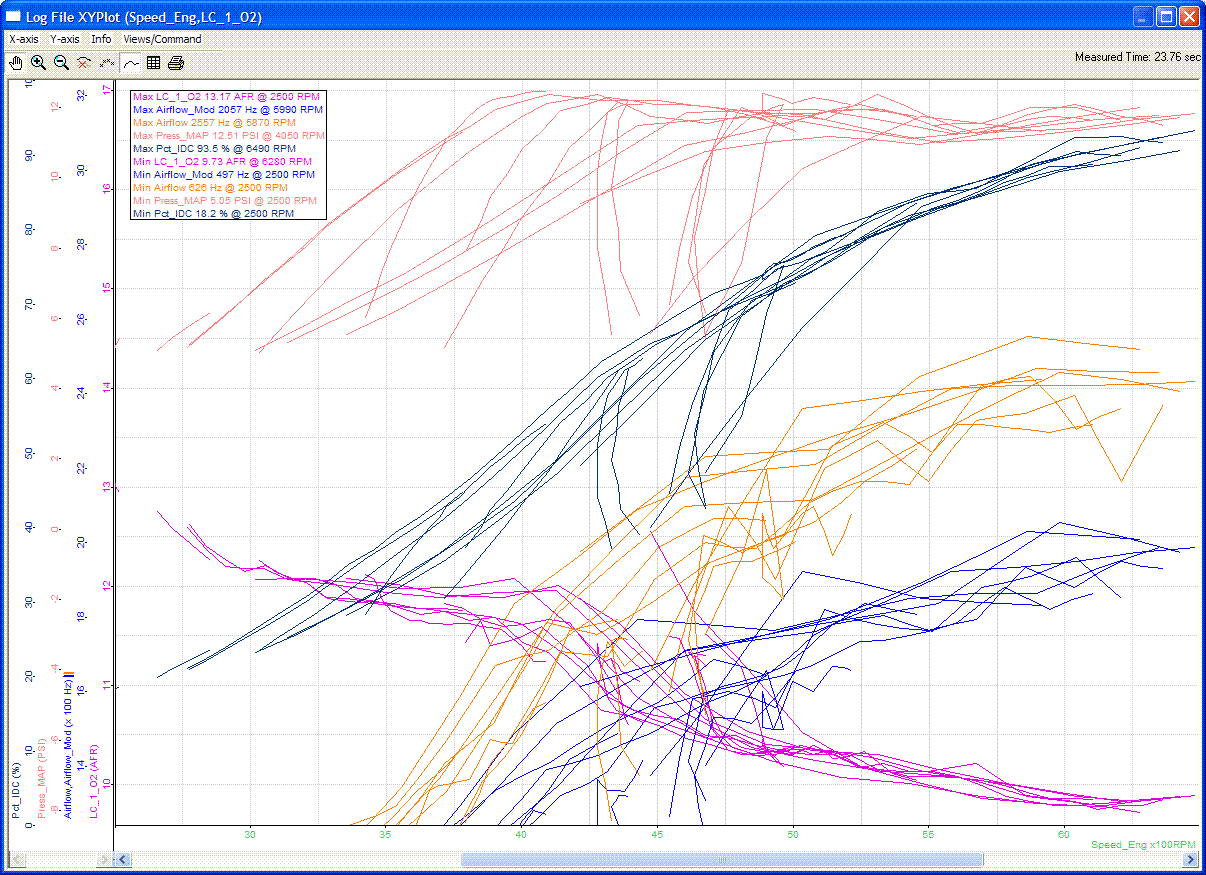
Details:
- Car/Setup Data
- Initial Data
- Troubleshooting
- Data Comparisons
- Data Comparisons
Car Info
| Year/Make/Model |
1995 Mitsubishi 3000GT VR-4 |
| Fuel Injectors |
450cc Denso (cleaned and balanced) |
| Fuel Control |
OEM ECU + AFC Neo |
| Ignition |
OEM (Plugs, Wires, Coils, PTU) |
| Engine |
6G72 |
|
|
| Rest TBD |
|
AFC Neo Info
| Program Version |
1.100 |
| Model Select |
V/T Off |
| Mode Select |
PRO |
| Car Select |
Cyl: 6 |
| Thr: <up arrow> |
| Sensor Select |
Karman |
| Analog Scale |
Rev: 8000 |
| Cor: +/- 50% |
| Warning Set |
Kar Warn: Off |
| Rev Warn: Off |
| Thr Warn: Off |
| Lo Throttle % |
30 |
| Hi Throttle % |
60 |
| Airflow Correction |
-19% at all RPM points |
Datalogger Info
| Log Generator |
Innovate Motorsports MTS Chain (with DL-32 or Laptop) |
| Airflow Logger |
Innovate SSI-4 (Frequency Mode) |
| Max Frequency Supported |
15kHz |
| Logfile Sample Spacing |
81.92ms |
| Airflow (MAF Sensor Value) Connection |
OEM Chassis Harness, about 3" from OEM ECU |
| Airflow_Mod (AFC Neo Output) Connection |
Brown/White Wire On AFC Neo Connection of Boomslang Harness |
|
|
|
|
|
|
| Rest TBD |
|
Basic Airflow Chart Example
| Input airflow |
from the OEM MAF sensor |
| Expected output airflow |
calculated as (Input_Airflow-19%) |
| MAP |
intake manifold pressure from GM 3-bar MAP sensor |
| Air-Fuel Ratio |
AFR measurement from LC-1 WBO2 sensor |
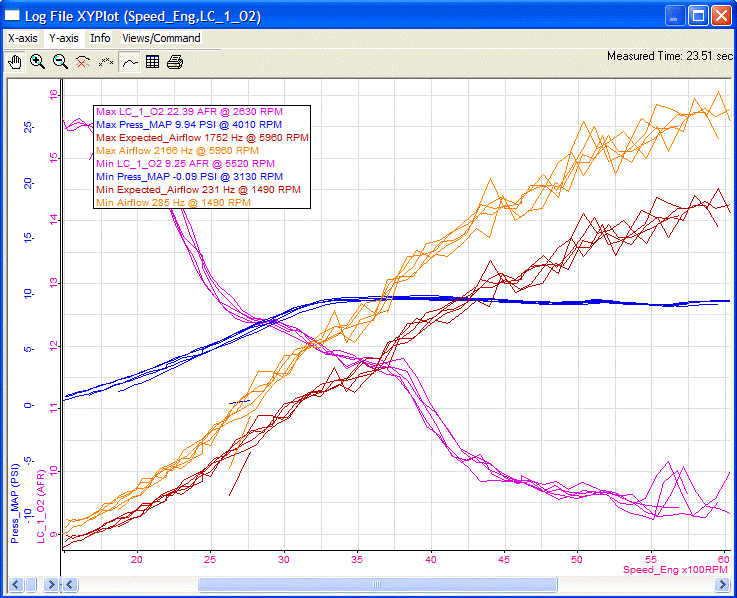
|
This is from a series of wide-open-throttle runs, plotted by RPM,
from around 1500RPM up to 6000RPM.
Maximum boost (10psi) is achieved by 3250RPM, and it is maintained above that RPM.
The AFC Neo correction values are set to -19% for all throttle and RPM points.
|
Let's Add the ACTUAL AFC Neo Airflow Output to the Graph...
| Input airflow |
from the OEM MAF sensor |
| Expected output airflow |
calculated as (Input_Airflow-19%) |
| MAP |
intake manifold pressure from GM 3-bar MAP sensor |
| Air-Fuel Ratio |
AFR measurement from LC-1 WBO2 sensor |
| AFC Neo Airflow Output |
Output Airflow Signal from AFC Neo(simulated Karman output) |
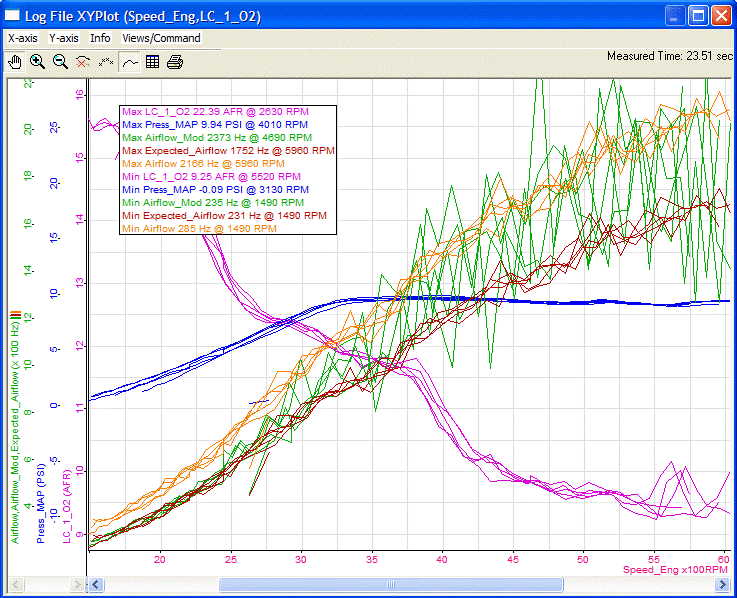
|
Uhhhh... something's not quite right here. The green (actual output)
line should be pretty much on top of the dark red (expected output) line.
It's very obviously not :(
|
What If We Apply A Smoothing Filter to the AFC Neo Output?
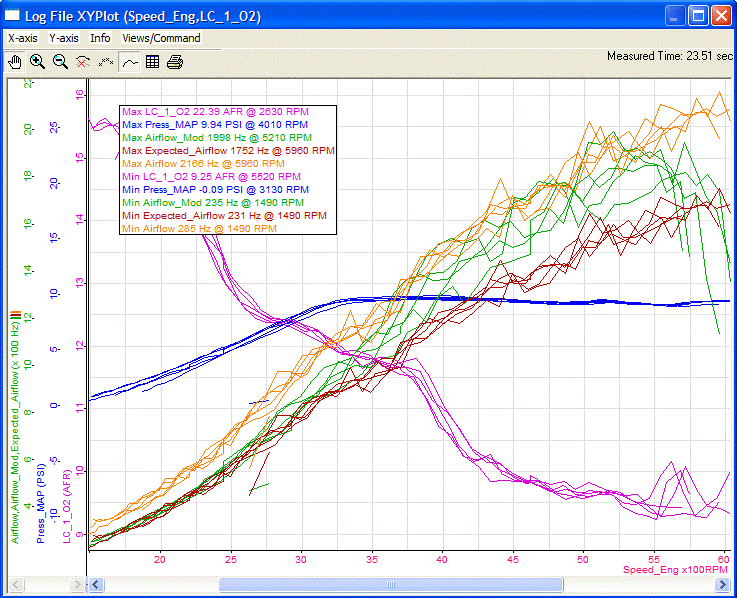
|
This still looks bad. Even with 0.41s of smoothing on the output
airflow signal, it's still nowhere near the red line. In fact,
many of the green lines are closer to the orange (input) data than
they are to the red (expected output) data! That means there's
effectively no correction going on, even though the AFC Neo is set
to -19% at all points.
|
What About Reducing Boost From 10psi to 6psi?
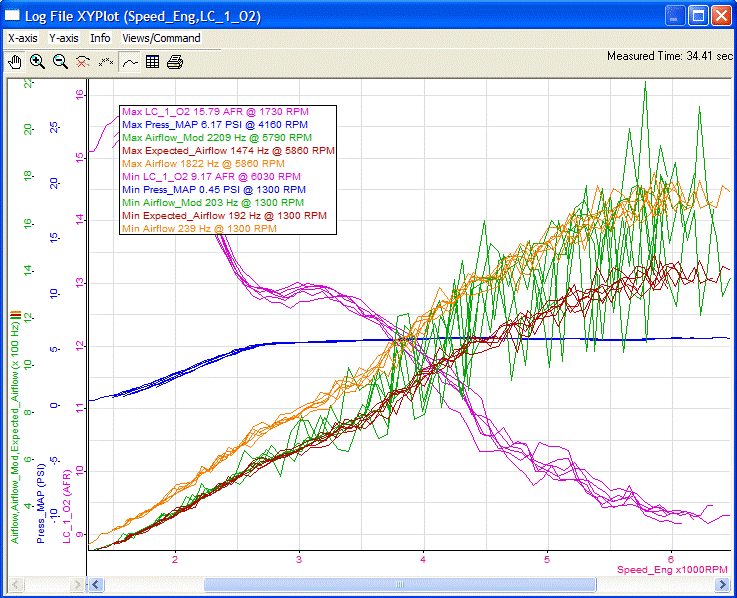
|
Pretty much same result - reducing boost to wastegate pressure (6psi) doesn't
help things...
|
Smoothed 6psi Data...
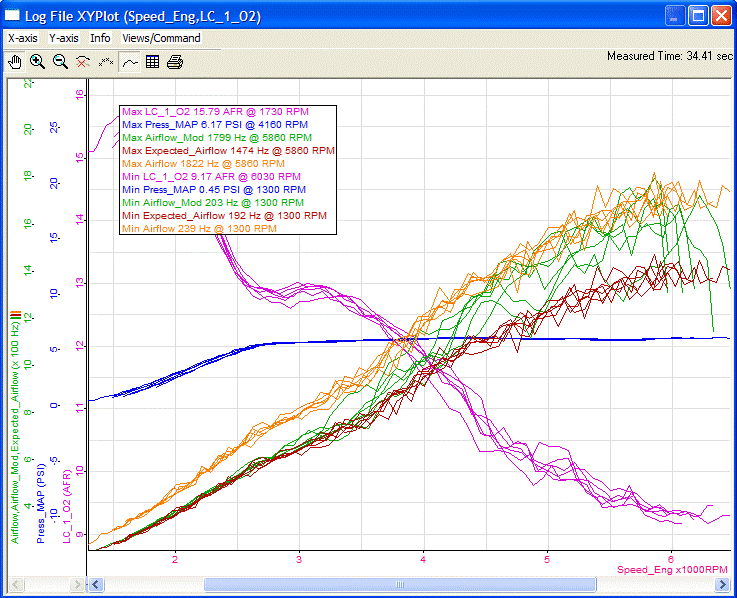
|
Again, doesn't look much better.
|
What About Trying Another AFC Neo?
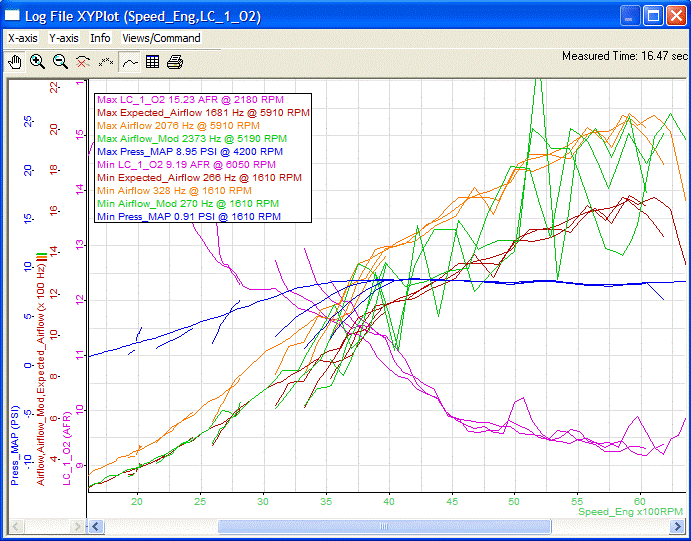
|
To gather this data, I used another AFC Neo, and that one even had
a different firmware version: v1.020. No dice. Same result.
|
What If I Set The Number of Cylinders to Twelve Instead of Six?
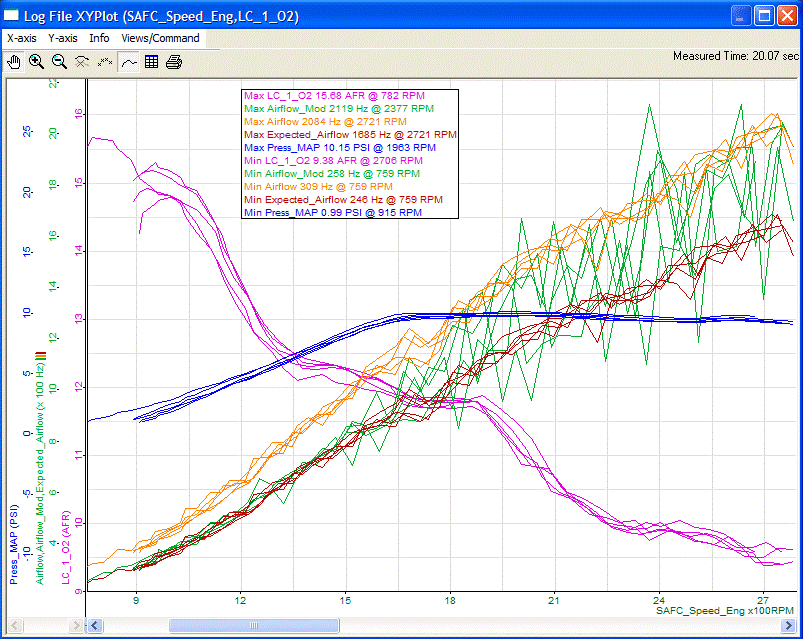
|
By doing this, I can trick the AFC Neo into only seeing half of the
engine's actual RPM - e.g. at 6000 engine RPM, the AFC will "see"
only 3000RPM. This should isolate the problem to an RPM issue or an airflow
issue. The data shows the airflow signal getting wacky at the same airflow
point, even though the RPM values seen by the AFC Neo are much lower.
This makes me think it's an airflow issue, and not something related
to engine RPM.
|
What About Configuring the AFC to "EASY" Mode Instead of "PRO" Mode?
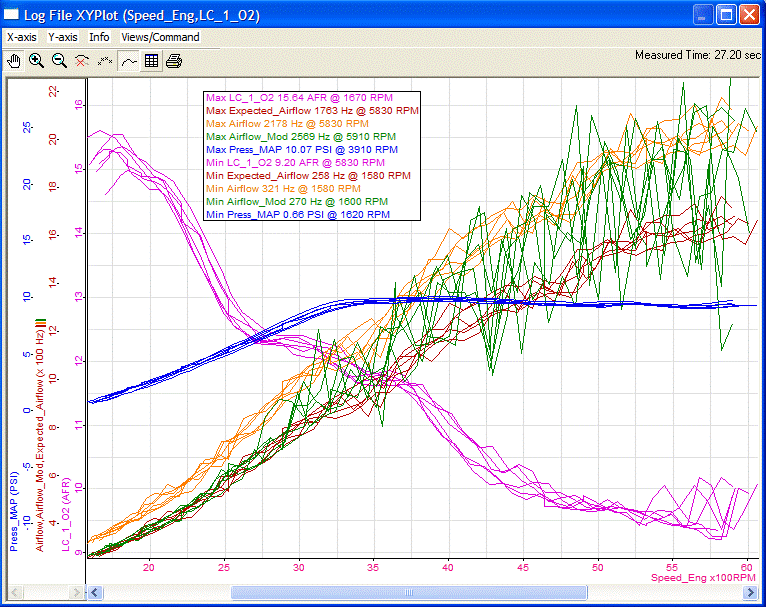
Comparison of Expected vs. Actual AFC Neo Airflow Output at 10psi
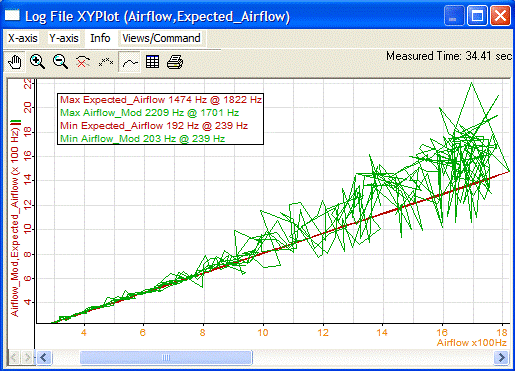
|
The dark red line is the expected airflow output from the AFC Neo. The green
line is the actual AFC Neo output. The green line definitely does not match the red line.
|
Comparison of Expected vs. Actual AFC Neo Airflow Output at 6psi
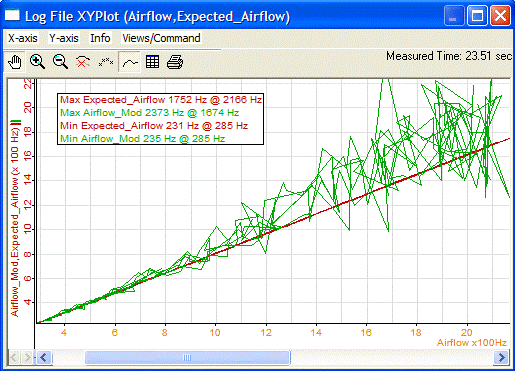
|
The dark red line is the expected airflow output from the AFC Neo. The green
line is the actual AFC Neo output. The green line definitely does not match the red line.
|
Comparison of Airflow Reading From OEM Chassis Harness with Boomslang Harness
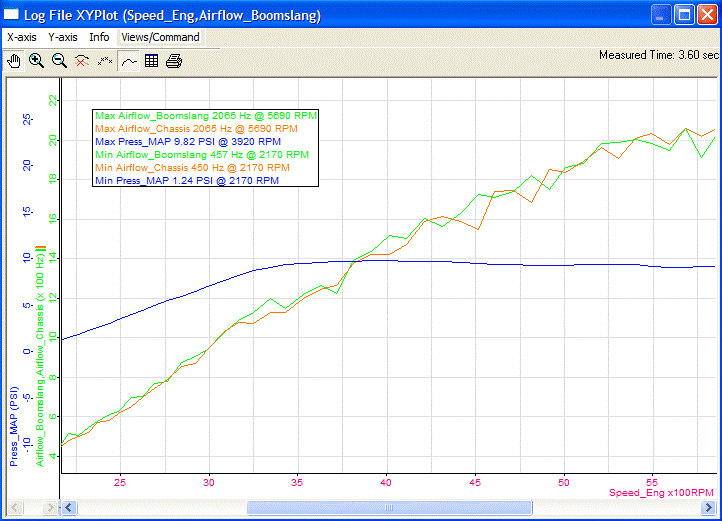
|
On this graph, I plotted the Airflow signal (in Hz), as measured from two different
points in the car. The first (orange) is the OEM chassis harness, and the second
is the output of the Boomslang harness (green), which is the direct input to the
AFC Neo. They seem to track pretty well, so I don't think the problem is
any kind of noise injected by the Boomslang harness.
|
What about Turning the Neo's Airflow Correction OFF?
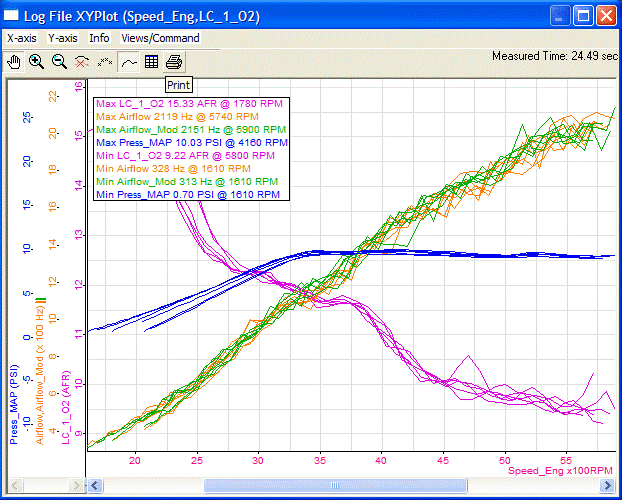
|
To gather this data, I lowered my fuel pressure enough to make my 450cc
injectors' flow pretty close to the flow of the OEM injectors (360cc).
This allowed me to turn the correction on the AFC Neo OFF and still
have the car run reasonably well. I took the car out with the
Neo connected, but correction OFF, and did some WOT pulls. As you can see,
the input and output airflow signals track very well. I also
observed that the car pulled smoothly to redline, without any of the surging
or roughness that I felt with the Neo correction enabled.
This, to me,
means that my wiring connections and the car's electrical connections
are ok. That also implies there is a hardware or firmware problem
with the AFC Neo. Based on trying this with two different AFC Neo
units (each with different firmware versions), this leads me to believe there
is a bug in the firmware or a hardware problem :-( I hope I'm wrong,
as I want my car to be operational soon...
|
History
May 15th, 2008:: I was contacted by the Operations Manager
After analyzing the data I gathered from my AFC Neo and testing another
Neo on a testbench, Apex has confirmed that there is a problem with the
Karman (frequency-based) airflow correction feature on current-generation
(firmware revision v1.103 or less)
AFC Neo products. As shown in my logs, the AFCís output is incorrect and
erratic under certain conditions, most notably when the input airflow
signal rises above 1000Hz. The problem does not seem to be limited to
anything specific to the 3000GT/Stealth platform, and likely applies to
any application using the Karman feature.
As you can see from my logs,
the output airflow is wildly inaccurate at times, and I do not recommend
that anyone use the Karman feature of the AFC Neo until Apex releases a
fix. For me, one temporary solution seems to be to keep the airflow
signal under 1000Hz, as the car seems to be have normally under those
conditions. The solution Iím currently using (so that I can run 450cc
injectors safely) is to decrease my base fuel pressure from 43psi to
33psi; that lowers the injector output enough that the OEM ECU can
compensate for the extra fuel. Then, I can either turn off the correction
on the AFC Neo or I can return the ECU wiring back to stock. This allows
me to drive the car without having to swap my OEM fuel injectors back
into the car.
Apex is working on a fix now, and Iím hoping to be able to test a
revised version within the next week or two(i.e. before the end of May).
Hopefully, the fix will
be a simple reflash of the firmware that can be applied to all existing
AFC Neos. Much to their credit Apex has (save an initial delay in
confirming the problem) been very responsive and seems to be trying to
do the right thing. I will post an update to this page when Iíve
received the revised version. If you have an AFC Neo, check back on
this page for updates -- as of now, I think I should have something to report
by the end of May.
First two weeks of May, 2008: I was contacted by the Operations Manager
of Apex Integration, who was extremely responsive and helpful. In his initial
e-mail, he offered to make things right for me personally and assured me that
Apex was working on the issue. He, like I, was puzzled that the AFC Neo has
been on the market for about 2 years now, and nobody has reported this issue
to Apex, either in Japan or the US. A few days later, I got an e-mail confirming
that there is a problem with the current generation of AFC Neo, and that Apex
was now working (quite feverishly, it seemed) on a firmware fix. As of now, it looks
like there may be a fix available near the end of May. As of the second week of May, my
AFC Neo is on its way to Apex, awaiting the updated firmware. Hopefully,
I'll be able to test it in my car after the Memorial Day weekend.
Various Dates in April, 2008: I exchanged a few more e-mails with
the Business Development Manager of Apex Integration, where he reported that
folks in the US and Japan were looking into it.
April 2nd, 2008: I tried a new experiment yesterday
(logging the AFC
input and output with the correction feature disabled)
and that seems to indicate
that my wiring and my car are ok. I called Apex Integration back today and
the tech agreed that it does sound like an issue with the Neo. He took down
my information (and I e-mailed him this URL) and he's going to forward this
info to the folks in Japan. If only the world were all in the same timezone...
March 31st, 2008: Since purchasing
an AFC Neo about a month ago and installing it a couple weeks ago,
I have been unable to get my
car to run a reasonable (read: leaner than 10:1 AFR at WOT) AFR without knock.
I have since isolated the problem to the airflow output from the AFC Neo.
The following charts and data show that, while the inputs to the AFC
seem to be reasonable, the airflow output of the AFC Neo goes haywire when the
airflow rises above 1kHz or so. The troubleshooting section shows some of the
tests I've done to confirm and isolate the problem.
Upon contacting Apex Integration
U.S.A. today, the tech recommended my logging input airflow from the AFC
harness instead of from the factory chassis harness, just to make sure that
I'm getting in/out data from the same general location (closest to the AFC Neo).
As you can see from the
"Comparison of Airflow Reading From OEM Chassis Harness with Boomslang Harness"
graph, there doesn't appear to be a meaningful
difference in the airflow signal between measuring it at the chassis harness
vs directly from the Neo harness. Next step is to call Apexi back and see
if there are any other things they'd like me to test.
|











